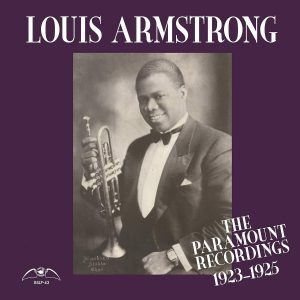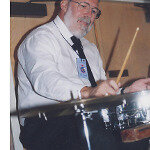 The recordings on this CD date from the last days of Louis Armstrong’s membership in the King Oliver Creole Jazz Band until the time when he left the Fletcher Henderson Orchestra to join his wife Lil Hardin’s Dreamland Syncopators, at which time also Armstrong’s famous Hot Five formed to record.
The recordings on this CD date from the last days of Louis Armstrong’s membership in the King Oliver Creole Jazz Band until the time when he left the Fletcher Henderson Orchestra to join his wife Lil Hardin’s Dreamland Syncopators, at which time also Armstrong’s famous Hot Five formed to record.
The first five tracks feature Armstrong playing second cornet with the Oliver band. Other than the two takes of the Fletcher Henderson’s Orchestra playing Mandy Make Up Your Mind, the other tracks all have the same five-piece combo drawn from the Henderson Orchestra, led by Armstrong, accompanying the singers, Ma Rainey’s being called her Georgia Jazz Band, Trixie Smith’s her Down Home Syncopators, and Coot Grant and Wesley Wilson’s simply the Fletcher Henderson’s Orchestra, despite its consisting of only five pieces.
Of all the cuts on this CD, perhaps the first five will be most familiar. Mabel’s Dream and Riverside Blues are often given an outing by today’s traditional jazz bands, Southern Stomps a little less so. David Sager’s notes provide a useful analysis of each of the tracks, where he points out some special effects to listen for, often between a track and its alternate. As he says, speaking of Southern Stomps, a favorite of mine, one should listen to Oliver and Armstrong “engage in some of the harmonized breaks that drive the crowd wild at Lincoln gardens.” These breaks come through loud and clear, even though the original recording was acoustic, and I have heard good bands playing the Oliver arrangements elicit a similar response to the breaks today at festivals and club dates.
The five cuts with Ma Rainey feature three pieces and alternates. The first, See See Rider, and third, Countin’ the Blues, have alternate takes with them; the other, Jelly Bean Blues, a lone take. Even though the recording was acoustic, the power of Rainey’s voice is clear. Backing her would have been no mean feat, but Armstrong is up to the task, using mutes à la King Oliver and not competing with her, but supporting her with obbligatos and answering phrases at the ends of some strains. On all five tracks he uses mutes; only in the four-measure turnaround at end of See See Rider does he remove the mute and play open horn.
Trixie Smith, whose tracks follow Ma Rainey’s, was not related to Bessie Smith, and she is not as well-known among blues aficionados, perhaps, as Rainey and Bessie Smith are. Unlike them, Trixie Smith was born into the black middle class, and she paid her dues in vaudeville and minstrel shows, as well as performing as a dancer, a comedian, an actress, and a singer. Her voice lacks the strength of Rainey’s which had a touch of coarseness and a plaintive quality, and while she utilizes vibrato, it is not throbbing, like that of Rainey. But in its way it is still definitive—even with a certain smoothness, she delivers blues that are convincing, that one can believe.
An exception to that might be her first track, You’ve Got to Beat Me to Keep Me, one that certainly would attract hordes of protesters today. She may well have had tongue-in-cheek inviting all the violence on her person, however, and this song could be a holdover from her vaudeville days. Once again Armstrong backs her with muted horn, giving a response, whether solo or leading the ensemble, to each phrase that she, as caller, utters, witness Mining Camp Blues or Railroad Blues.
The final vocals are delivered by a duo, Coot Grant and Wesley Wilson. Rather than blues singers, I would be more inclined classify them as a vaudeville act, given their treatment of the songs. These are half sung/half talked, occasionally backed with stop chords. The songs are interspersed with badinage aimed to amuse. It is all quite entertaining, but not quite the blues for me. Although well in the background, Armstrong plays both melody and response by turns, backing the vocals on these last cuts, as well as coming forward to lead the ensemble on occasion between vocal strains.
Although some of the tracks on this CD were issued in the past by Jazzology on LP (BSLP-43), that album did not contain all of the alternate tracks this one does. Also the CD has an extra track, You’ve Got to Beat Me to Keep Me, by Trixie Smith. An additional bonus is the first rate digital transferring, restoration, and mastering by Doug Benson, resulting in a fine album that brings these several disparate recording occasions together and that should appeal greatly to blues fans and Armstrong buffs. Not to denigrate Benson’s work, which gives us the best auditory experience possible, one can only sigh at the thought of what it all would have sounded like had the recording been electrical rather than acoustic. This is a CD well worth having.
Louis Armstrong: The Paramount Recordings – 1923-1925
Black Swan BSCD-43; Playing time: 72m. 15s
King Oliver’s Jazz Band (Chicago, 1923): Mabel’s Dream (Tk 1); Mabel’s Dream (Tk 2); The Southern Stomps (Tk 1); The Southern Stomps (Tk 2); Riverside Blues
Ma Rainey (v) and Her Georgia Jazz Band (NY 1924): See See Rider (Tk 1); See See Rider (Tk 2); Jelly Bean Blues (Tk 2); Countin’ the Blues (Tk 2); Countin’ the Blues (Tk 3)
Fletcher Henderson Orchestra: Mandy Make Up Your Mind (Tk 1); Mandy Make Up Your Mind (Tk 2)
Trixie Smith (v) and Her Down Home Syncopators (NY 1925): You’ve Got to Beat Me to Keep Me (Tk 2); Mining Camp Blues (Tk 1); Mining Camp Blues (Tk 2); The World’s Jazz Crazy (and So Am I) (Tk 1); The World’s Jazz Crazy (and So Am I) (Tk 2); Railroad Blues (Tk 1); Railroad Blues (Tk 2)
Coot Grant (v) & Wesley Wilson (v) acc. by Fletcher Henderson’s Orchestra (NY 1925): You Dirty Mistreater (Tk 1); Come On Coot and Do That Thing (Tk 2); Have Your Chill, I’ll Be Here When Your Fever Rises (Tk 2); Find Me at the Greasy Spoon (If You Miss Me Here) (Tk 1); Find Me at the Greasy Spoon (If You Miss Me Here) (Tk 2)
Personnel: all are listed in the CD booklet.
Born in Dundee, Scotland, Bert Thompson came to the U.S. in 1956. After a two-year stint playing drums with the 101 st Airborne Division Band and making a number of parachute drops, he returned to civilian life in San Francisco, matriculating at San Francisco State University where he earned a B.A. and an M.A. He went on to matriculate at University of Oregon, where he earned a D.A. and a Ph.D., all of his degrees in English. Now retired, he is a professor emeritus of English at City College of San Francisco. He is also a retired traditional jazz drummer, having played with a number of San Francisco Bay Area bands, including And That’s Jazz, Professor Plum’s Jazz, the Jelly Roll Jazz Band, Mission Gold Jazz Band, and the Zenith New Orleans Parade band; he also played with some further afield, including Gremoli (Long Beach, CA) and the Phoenix Jazzers (Vancouver, B.C.) Today he reviews traditional jazz CDs and writes occasional articles for several publications.






















